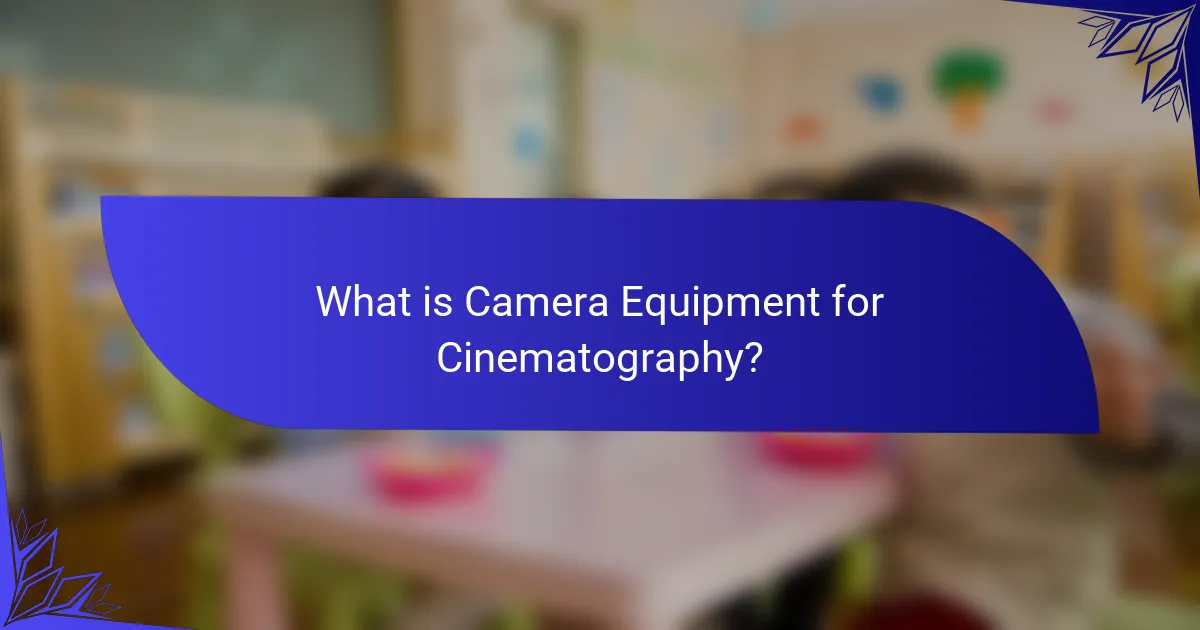Camera equipment for cinematography encompasses the various tools and devices essential for capturing moving images, including cameras, lenses, tripods, gimbals, and lighting equipment. Each component plays a specific role: cameras record visual content, lenses influence focus and depth of field, tripods ensure stability, gimbals facilitate smooth motion, and lighting equipment controls exposure. The article provides an overview of different types of camera equipment, their functions in film production, and recommendations for high-quality gear, such as the ARRI Alexa and RED Komodo cameras, Canon CN-E series lenses, and stabilization tools like gimbals. Additionally, it highlights essential accessories that enhance filmmaking capabilities.

What is Camera Equipment for Cinematography?
Camera equipment for cinematography refers to the tools and devices used to capture moving images. This includes cameras, lenses, tripods, gimbals, and lighting equipment. Cameras are the primary devices that record visual content. Lenses affect the focus, depth of field, and overall image quality. Tripods provide stability, while gimbals help in achieving smooth motion shots. Lighting equipment is essential for controlling exposure and setting the mood. Together, these components enable filmmakers to create visually compelling narratives.
How does camera equipment impact cinematography?
Camera equipment significantly impacts cinematography by determining image quality and visual storytelling. High-quality cameras capture more detail, enhancing the overall aesthetic. Lenses affect depth of field and focus, influencing how viewers perceive scenes. Stabilization tools like gimbals ensure smooth motion, improving visual fluidity. Lighting equipment shapes mood and atmosphere, crucial for storytelling. Different sensors can alter dynamic range and color accuracy, affecting the final output. The choice of equipment directly influences the creative decisions made by cinematographers. Research from the American Society of Cinematographers emphasizes the importance of equipment selection in achieving desired visual effects.
What are the essential components of camera equipment?
The essential components of camera equipment include the camera body, lens, tripod, and lighting. The camera body captures images and videos. It houses the sensor and controls for exposure. The lens focuses light onto the sensor. Different lenses provide various focal lengths and apertures. A tripod stabilizes the camera during shooting. It prevents unwanted movement and shakes. Lighting is crucial for visibility and mood. Proper lighting enhances image quality and detail.
How do different camera types influence cinematography?
Different camera types significantly influence cinematography through their unique technical capabilities and aesthetic qualities. DSLR cameras offer versatility and high-quality images, making them popular for independent films. Film cameras provide a distinct look due to their grain structure, often sought after for artistic projects. Digital cinema cameras excel in dynamic range and low-light performance, enhancing visual storytelling. Action cameras are compact and durable, allowing for creative angles in extreme conditions. Each camera type impacts framing, depth of field, and motion capture, shaping the overall narrative style. The choice of camera directly affects lighting, composition, and editing techniques, ultimately influencing audience perception.
What are the main types of camera equipment used in cinematography?
The main types of camera equipment used in cinematography include cameras, lenses, tripods, and lighting. Cameras are the primary devices for capturing moving images. They come in various formats, including digital and film. Lenses are crucial for determining the image quality and perspective. They vary in focal length and aperture. Tripods provide stability for camera setups during filming. They help in achieving smooth shots. Lighting equipment is essential for controlling the exposure and mood of scenes. It includes softboxes, reflectors, and spotlights. Each type of equipment plays a vital role in the cinematographic process, contributing to the overall visual storytelling.
What is the role of lenses in cinematography?
Lenses in cinematography are essential for capturing images. They determine the field of view, focus, and depth of field. Different lenses create distinct visual styles. For instance, wide-angle lenses expand the scene, while telephoto lenses compress it. The choice of lens affects the storytelling and emotional impact of a shot. Lenses also influence lighting and exposure settings. High-quality lenses can enhance image clarity and reduce distortion. Cinematographers select lenses based on the desired aesthetic and narrative requirements.
How do camera bodies differ in functionality?
Camera bodies differ in functionality primarily through sensor size, image processing capabilities, and connectivity options. Sensor size affects image quality and depth of field. Larger sensors typically produce better low-light performance and dynamic range. Image processing capabilities determine how quickly and efficiently images are processed. Faster processors enable higher frame rates and better autofocus performance. Connectivity options include Wi-Fi, Bluetooth, and HDMI, affecting how easily the camera can share images and connect to external devices. Different camera bodies cater to various needs, such as professional cinematography or casual photography.
What accessories are crucial for cinematographic work?
Essential accessories for cinematographic work include tripods, lighting equipment, and microphones. Tripods provide stability for shots, ensuring smooth camera movements. Lighting equipment is crucial for achieving the desired mood and visibility in scenes. Microphones capture high-quality audio, which is vital for storytelling. Other important accessories are lens filters, which enhance image quality, and gimbals, which stabilize camera movements. These accessories collectively improve the production value of cinematographic projects.

What functions do different camera equipment serve in cinematography?
Different camera equipment serves various functions in cinematography. Cameras capture images and record motion. Lenses control focus, depth of field, and perspective. Tripods stabilize shots and prevent unwanted movement. Gimbals provide balance for smooth tracking shots. Lighting equipment enhances visibility and sets the mood. Microphones capture audio, essential for dialogue and sound effects. Filters alter light and color, affecting the final image. Each piece of equipment contributes to the overall visual storytelling in film production.
How do various lenses affect image quality?
Various lenses significantly impact image quality by influencing factors such as sharpness, distortion, and color rendition. Prime lenses typically offer superior sharpness due to their simpler optical designs. Zoom lenses provide versatility but may exhibit more distortion and reduced sharpness at extremes.
Wide-angle lenses can introduce barrel distortion, affecting straight lines in images. Telephoto lenses often compress depth and enhance subject isolation but can be sensitive to camera shake.
Lens coatings also play a crucial role; multi-coated lenses reduce lens flare and improve contrast. The aperture size influences depth of field and light intake, affecting the overall exposure and bokeh quality.
Quality glass and construction materials contribute to durability and optical performance. High-quality lenses often provide better image quality across various settings, as confirmed by comparative reviews in photography literature.
What types of lenses are commonly used in cinematography?
Commonly used lenses in cinematography include prime lenses, zoom lenses, and anamorphic lenses. Prime lenses have a fixed focal length, which offers superior image quality and faster apertures. Zoom lenses provide variable focal lengths, allowing for versatile framing without changing lenses. Anamorphic lenses create a wider aspect ratio and unique lens flares, enhancing cinematic storytelling. Each lens type serves specific creative purposes in filmmaking. For example, prime lenses are favored for their sharpness, while zoom lenses are preferred for dynamic shooting situations. Anamorphic lenses are often used in high-budget productions to achieve a distinct visual style.
How does focal length impact cinematographic shots?
Focal length significantly impacts cinematographic shots by determining the field of view and perspective. A shorter focal length, like 18mm, creates a wider field of view. This allows more of the scene to be captured, making it ideal for landscapes or tight spaces. Conversely, a longer focal length, such as 200mm, narrows the field of view. This results in a more compressed perspective, which is useful for isolating subjects and creating a sense of intimacy.
Focal length also affects depth of field. Shorter focal lengths tend to have a greater depth of field, keeping more elements in focus. Longer focal lengths usually produce a shallower depth of field, allowing for blurred backgrounds that emphasize the subject.
The choice of focal length influences the emotional tone of a shot. Wider angles can create a sense of openness and freedom, while telephoto lenses can evoke feelings of isolation or focus. Cinematographers strategically select focal lengths to achieve specific storytelling goals.
What are the functions of camera stabilizers and rigs?
Camera stabilizers and rigs serve to reduce camera shake and enhance stability during filming. They allow for smoother motion and improved shot quality. Stabilizers help maintain a steady frame, even in dynamic environments. Rigs provide support for various camera setups, distributing weight for easier handling. They enable filmmakers to achieve complex shots, such as tracking and panning, without losing stability. These tools are essential for professional cinematography, ensuring consistent and high-quality visuals.
How do stabilizers enhance shooting quality?
Stabilizers enhance shooting quality by reducing unwanted camera movement. They provide a steady platform for the camera, which leads to smoother footage. This stabilization minimizes the effects of shaking caused by walking or other movements. As a result, the final video appears more professional and visually appealing. Stabilizers can also help maintain framing and composition during dynamic shots. They are essential for achieving cinematic quality in various filming conditions. Studies show that stabilized footage is preferred by audiences for its clarity and fluidity.
What types of rigs are available for cinematographers?
Cinematographers have access to various types of rigs. These include shoulder rigs, which provide stability for handheld shooting. There are also tripod rigs, offering support for static shots. Gimbal rigs assist in achieving smooth motion shots. Dollies enable movement along tracks for dynamic scenes. Jib rigs allow for elevated camera angles and sweeping shots. Steadicams are designed for fluid motion without shake. Finally, drone rigs provide aerial perspectives. Each rig serves specific filming needs and enhances visual storytelling.

What are the best recommendations for camera equipment in cinematography?
The best recommendations for camera equipment in cinematography include high-quality cameras, lenses, and stabilization tools. Popular camera choices are the ARRI Alexa and RED Komodo. These cameras provide exceptional image quality and dynamic range. For lenses, prime lenses like the Canon CN-E series offer sharpness and low distortion. Zoom lenses such as the Fujinon MK series provide versatility for various shooting scenarios. Stabilization equipment like gimbals and Steadicams enhance smoothness in motion shots. Additionally, essential accessories include filters, tripods, and external monitors for improved control and flexibility. This equipment is widely endorsed by industry professionals for its reliability and performance.
What should beginners consider when choosing camera equipment?
Beginners should consider several key factors when choosing camera equipment. First, the type of photography or videography they intend to pursue is crucial. Different genres require specific equipment features. For instance, landscape photography benefits from wide-angle lenses, while portrait photography often requires prime lenses.
Next, beginners should evaluate their budget. Camera equipment can range widely in price, and setting a budget helps narrow down options. Additionally, understanding the importance of sensor size is vital. Larger sensors typically yield better image quality, especially in low light conditions.
Portability is another essential consideration. Beginners may prefer lightweight equipment for ease of transport. Furthermore, the availability of lenses and accessories compatible with the camera system should be assessed. A versatile system allows for future upgrades and varied shooting styles.
Lastly, beginners should read reviews and seek recommendations from experienced photographers. This can provide insights into the performance and reliability of different models. Choosing equipment that suits their specific needs will enhance their learning and creative expression.
What are the most user-friendly options for novice cinematographers?
The most user-friendly options for novice cinematographers include DSLR cameras, mirrorless cameras, and compact cameras. DSLR cameras, such as the Canon EOS Rebel T7, offer intuitive controls and reliable performance. Mirrorless cameras, like the Sony Alpha a6000, provide lightweight designs and advanced features. Compact cameras, such as the Canon PowerShot G7 X Mark III, are portable and easy to use. Each of these options features automatic modes that simplify the filming process. They also have built-in tutorials or guides that assist beginners. These cameras are widely recommended in beginner cinematography resources for their accessibility and versatility.
How can budget constraints influence equipment choices?
Budget constraints significantly influence equipment choices by limiting the range of available options. When budgets are tight, filmmakers must prioritize essential features over luxury items. This often leads to selecting more affordable brands or models that meet basic requirements. For instance, filmmakers might opt for a camera with fewer advanced features but suitable image quality. Additionally, budget limitations can necessitate the use of rental equipment instead of purchasing. According to a report by the International Cinematographers Guild, 70% of independent filmmakers face budget constraints that affect their equipment decisions. Thus, financial limitations directly shape the quality and type of cinematography equipment chosen.
What equipment do professionals recommend for high-quality cinematography?
Professionals recommend high-quality cameras, lenses, stabilizers, and lighting for cinematography. Cameras like the ARRI Alexa and RED Komodo are industry standards. These cameras offer superior image quality and dynamic range. High-quality lenses, such as those from Zeiss and Canon, enhance visual storytelling. Stabilizers like gimbals ensure smooth motion during filming. Lighting equipment, including LED panels and softboxes, is essential for controlling the scene’s mood. Each piece of equipment contributes to the overall cinematic quality. Their recommendations are based on years of industry experience and successful productions.
Which brands are trusted by industry professionals?
Canon, Sony, and Panasonic are trusted brands by industry professionals in cinematography. Canon is known for its high-quality lenses and cameras, particularly the EOS series. Sony offers advanced technology, especially with its mirrorless cameras, like the A7 series. Panasonic is recognized for its reliable video performance, particularly with the Lumix GH series. These brands consistently receive positive reviews from professionals for their durability and image quality.
What features should be prioritized in professional-grade equipment?
Professional-grade equipment should prioritize image quality, durability, and versatility. Image quality is essential for capturing high-resolution footage with accurate color reproduction. High dynamic range (HDR) capabilities enhance detail in both highlights and shadows. Durability ensures that the equipment can withstand harsh shooting conditions. Weather-sealed bodies and robust materials contribute to longevity. Versatility allows for adaptability across various shooting scenarios. Features like interchangeable lenses and modular designs increase creative options. Additionally, advanced autofocus systems improve focus accuracy and speed. These features collectively enhance the overall performance of professional-grade equipment in cinematography.
What are the common troubleshooting tips for camera equipment?
Common troubleshooting tips for camera equipment include checking battery levels, ensuring memory cards are properly inserted, and inspecting lens connections. If the camera won’t turn on, replace or recharge the battery. If images are not saving, verify that the memory card has enough space and is formatted correctly. For blurry images, check if the lens is clean and properly focused. If there are error messages, consult the camera’s manual for specific codes. Regularly updating firmware can resolve many issues. Additionally, using a tripod can help stabilize shots and reduce camera shake. These practices help maintain optimal camera performance and prevent common problems.
Camera equipment for cinematography encompasses the essential tools and devices used to capture moving images, including cameras, lenses, tripods, gimbals, and lighting equipment. This article provides a comprehensive overview of the types, functions, and recommendations for cinematographic equipment, emphasizing how each component influences image quality and visual storytelling. Key topics include the impact of different camera types, the role of lenses, essential accessories, and expert recommendations for high-quality gear. Additionally, it addresses considerations for beginners and troubleshooting tips to enhance the filming process.